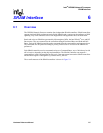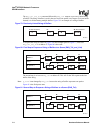
Hardware Reference Manual 215
Intel
®
IXP2800 Network Processor
SRAM Interface
There are two different modes for the dequeue command. One mode removes an entire buffer from
the queue. The second mode removes a piece of the buffer (referred to as a cell). The mode (cell
dequeue or buffer dequeue) is selectable on a buffer-by-buffer basis by setting the
cell_count
bits (
<30:24>) in the link longword.
A ring is an ordered list of data words stored in a fixed block of contiguous addresses. A ring is
described by a head pointer and a tail pointer. Data is written, using the
put command, to a ring at
the address contained in the tail pointer and the tail pointer is incremented. Data is read, using the
get command, from a ring at the address contained in the head pointer and the head pointer is
incremented. Whenever either pointer reaches the end of the ring, the pointer is wrapped back to
the address of the start of the ring.
A journal is similar to a ring. It is generally used for debugging. Journal commands only write to
the data structure. New data overwrites the oldest data. Microcode can choose to tag the journal
data with the Microengine number and CTX number of the journal writer.
The
Q_array to support queuing, rings and journals contains 64 registers per SRAM channel. For
a design with a large number of queues, the queue descriptors cannot all be stored on the chip, and
thus a subset of the queue descriptors (16) is cached in the Q_array. (To implement the cache, 16
contiguous Q_array registers must be allocated.) The cache tag (the mapping of queue number to
Q_array registers) for the Q_array is maintained by microcode in the CAM of a Microengine.
The writeback and load of the cached registers in the
Q_array is under the control of that
microcode.
Note: The size of the
Q_array does not set a limit on the number of queues supported.
For other queues (free buffer pools, for example), rings, and journals, the information does not
need to be subsetted and thus can be loaded into the
Q_array at initialization time and left there to
be updated solely by the SRAM controller.
The sum total of the cached queue descriptors plus the number of rings, journals, and static queues
must be less than or equal to 64 for a given SRAM channel.
The fields and sizes of the
Q_array registers are shown in Table 73 and Table 74. All addresses
are of type longword, and are 32 bits in length.
Table 73. Queue Format
Name
Longword
Number
Bit
Number
1
1. Bits 31:24 of longword number 2 are available for use by microcode.
Definition
EOP 0 31 End of Packet — decrement Q_count on dequeue
SOP 0 30 Start of Packet — used by the programmer
Cell Count 0 29:24 Number of cells in the buffer
Head 0 23:0 Head pointer
Tail 1 23:0 Tail pointer
Q_count 2 23:0 Number of packets on the queue or number of buffers on the queue
SW_Private 2 31:24 Ignored by hardware, returned to Microengine
Head Valid N/A Cached head pointer valid — maintained by hardware
Tail Valid N/A Cached tail pointer valid — maintained by hardware


















